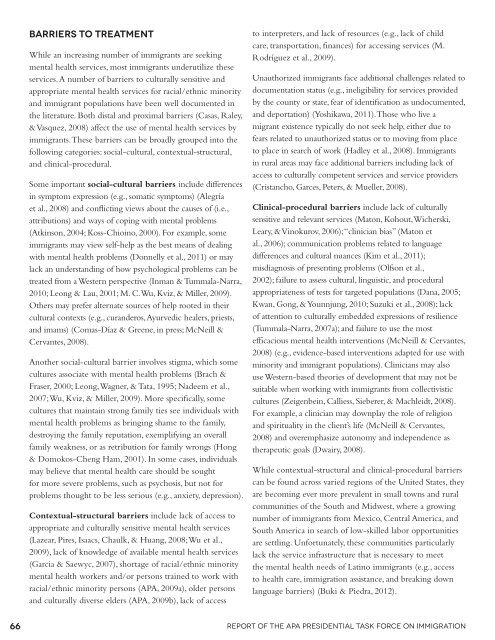Crossroads: The Psychology of Immigration in the New Century
Crossroads: The Psychology of Immigration in the New Century
Crossroads: The Psychology of Immigration in the New Century
You also want an ePaper? Increase the reach of your titles
YUMPU automatically turns print PDFs into web optimized ePapers that Google loves.
Barriers to Treatment<br />
While an <strong>in</strong>creas<strong>in</strong>g number <strong>of</strong> immigrants are seek<strong>in</strong>g<br />
mental health services, most immigrants underutilize <strong>the</strong>se<br />
services. A number <strong>of</strong> barriers to culturally sensitive and<br />
appropriate mental health services for racial/ethnic m<strong>in</strong>ority<br />
and immigrant populations have been well documented <strong>in</strong><br />
<strong>the</strong> literature. Both distal and proximal barriers (Casas, Raley,<br />
& Vasquez, 2008) affect <strong>the</strong> use <strong>of</strong> mental health services by<br />
immigrants. <strong>The</strong>se barriers can be broadly grouped <strong>in</strong>to <strong>the</strong><br />
follow<strong>in</strong>g categories: social-cultural, contextual-structural,<br />
and cl<strong>in</strong>ical-procedural.<br />
Some important social-cultural barriers <strong>in</strong>clude differences<br />
<strong>in</strong> symptom expression (e.g., somatic symptoms) (Alegría<br />
et al., 2008) and conflict<strong>in</strong>g views about <strong>the</strong> causes <strong>of</strong> (i.e.,<br />
attributions) and ways <strong>of</strong> cop<strong>in</strong>g with mental problems<br />
(Atk<strong>in</strong>son, 2004; Koss-Chio<strong>in</strong>o, 2000). For example, some<br />
immigrants may view self-help as <strong>the</strong> best means <strong>of</strong> deal<strong>in</strong>g<br />
with mental health problems (Donnelly et al., 2011) or may<br />
lack an understand<strong>in</strong>g <strong>of</strong> how psychological problems can be<br />
treated from a Western perspective (Inman & Tummala-Narra,<br />
2010; Leong & Lau, 2001; M. C. Wu, Kviz, & Miller, 2009).<br />
O<strong>the</strong>rs may prefer alternate sources <strong>of</strong> help rooted <strong>in</strong> <strong>the</strong>ir<br />
cultural contexts (e.g., curanderos, Ayurvedic healers, priests,<br />
and imams) (Comas-Díaz & Greene, <strong>in</strong> press; McNeill &<br />
Cervantes, 2008).<br />
Ano<strong>the</strong>r social-cultural barrier <strong>in</strong>volves stigma, which some<br />
cultures associate with mental health problems (Brach &<br />
Fraser, 2000; Leong, Wagner, & Tata, 1995; Nadeem et al.,<br />
2007; Wu, Kviz, & Miller, 2009). More specifically, some<br />
cultures that ma<strong>in</strong>ta<strong>in</strong> strong family ties see <strong>in</strong>dividuals with<br />
mental health problems as br<strong>in</strong>g<strong>in</strong>g shame to <strong>the</strong> family,<br />
destroy<strong>in</strong>g <strong>the</strong> family reputation, exemplify<strong>in</strong>g an overall<br />
family weakness, or as retribution for family wrongs (Hong<br />
& Domokos-Cheng Ham, 2001). In some cases, <strong>in</strong>dividuals<br />
may believe that mental health care should be sought<br />
for more severe problems, such as psychosis, but not for<br />
problems thought to be less serious (e.g., anxiety, depression).<br />
Contextual-structural barriers <strong>in</strong>clude lack <strong>of</strong> access to<br />
appropriate and culturally sensitive mental health services<br />
(Lazear, Pires, Isaacs, Chaulk, & Huang, 2008; Wu et al.,<br />
2009), lack <strong>of</strong> knowledge <strong>of</strong> available mental health services<br />
(Garcia & Saewyc, 2007), shortage <strong>of</strong> racial/ethnic m<strong>in</strong>ority<br />
mental health workers and/or persons tra<strong>in</strong>ed to work with<br />
racial/ethnic m<strong>in</strong>ority persons (APA, 2009a), older persons<br />
and culturally diverse elders (APA, 2009b), lack <strong>of</strong> access<br />
to <strong>in</strong>terpreters, and lack <strong>of</strong> resources (e.g., lack <strong>of</strong> child<br />
care, transportation, f<strong>in</strong>ances) for access<strong>in</strong>g services (M.<br />
Rodríguez et al., 2009).<br />
Unauthorized immigrants face additional challenges related to<br />
documentation status (e.g., <strong>in</strong>eligibility for services provided<br />
by <strong>the</strong> county or state, fear <strong>of</strong> identification as undocumented,<br />
and deportation) (Yoshikawa, 2011). Those who live a<br />
migrant existence typically do not seek help, ei<strong>the</strong>r due to<br />
fears related to unauthorized status or to mov<strong>in</strong>g from place<br />
to place <strong>in</strong> search <strong>of</strong> work (Hadley et al., 2008). Immigrants<br />
<strong>in</strong> rural areas may face additional barriers <strong>in</strong>clud<strong>in</strong>g lack <strong>of</strong><br />
access to culturally competent services and service providers<br />
(Cristancho, Garces, Peters, & Mueller, 2008).<br />
Cl<strong>in</strong>ical-procedural barriers <strong>in</strong>clude lack <strong>of</strong> culturally<br />
sensitive and relevant services (Maton, Kohout, Wicherski,<br />
Leary, & V<strong>in</strong>okurov, 2006); “cl<strong>in</strong>ician bias” (Maton et<br />
al., 2006); communication problems related to language<br />
differences and cultural nuances (Kim et al., 2011);<br />
misdiagnosis <strong>of</strong> present<strong>in</strong>g problems (Olfson et al.,<br />
2002); failure to assess cultural, l<strong>in</strong>guistic, and procedural<br />
appropriateness <strong>of</strong> tests for targeted populations (Dana, 2005;<br />
Kwan, Gong, & Younnjung, 2010; Suzuki et al., 2008); lack<br />
<strong>of</strong> attention to culturally embedded expressions <strong>of</strong> resilience<br />
(Tummala-Narra, 2007a); and failure to use <strong>the</strong> most<br />
efficacious mental health <strong>in</strong>terventions (McNeill & Cervantes,<br />
2008) (e.g., evidence-based <strong>in</strong>terventions adapted for use with<br />
m<strong>in</strong>ority and immigrant populations). Cl<strong>in</strong>icians may also<br />
use Western-based <strong>the</strong>ories <strong>of</strong> development that may not be<br />
suitable when work<strong>in</strong>g with immigrants from collectivistic<br />
cultures (Zeigenbe<strong>in</strong>, Calliess, Sieberer, & Machleidt, 2008).<br />
For example, a cl<strong>in</strong>ician may downplay <strong>the</strong> role <strong>of</strong> religion<br />
and spirituality <strong>in</strong> <strong>the</strong> client’s life (McNeill & Cervantes,<br />
2008) and overemphasize autonomy and <strong>in</strong>dependence as<br />
<strong>the</strong>rapeutic goals (Dwairy, 2008).<br />
While contextual-structural and cl<strong>in</strong>ical-procedural barriers<br />
can be found across varied regions <strong>of</strong> <strong>the</strong> United States, <strong>the</strong>y<br />
are becom<strong>in</strong>g ever more prevalent <strong>in</strong> small towns and rural<br />
communities <strong>of</strong> <strong>the</strong> South and Midwest, where a grow<strong>in</strong>g<br />
number <strong>of</strong> immigrants from Mexico, Central America, and<br />
South America <strong>in</strong> search <strong>of</strong> low-skilled labor opportunities<br />
are settl<strong>in</strong>g. Unfortunately, <strong>the</strong>se communities particularly<br />
lack <strong>the</strong> service <strong>in</strong>frastructure that is necessary to meet<br />
<strong>the</strong> mental health needs <strong>of</strong> Lat<strong>in</strong>o immigrants (e.g., access<br />
to health care, immigration assistance, and break<strong>in</strong>g down<br />
language barriers) (Buki & Piedra, 2012).<br />
66 Report <strong>of</strong> <strong>the</strong> APA Presidential Task Force on <strong>Immigration</strong>
















